Renzo Protocol
Generate extra income with Renzo and Notum
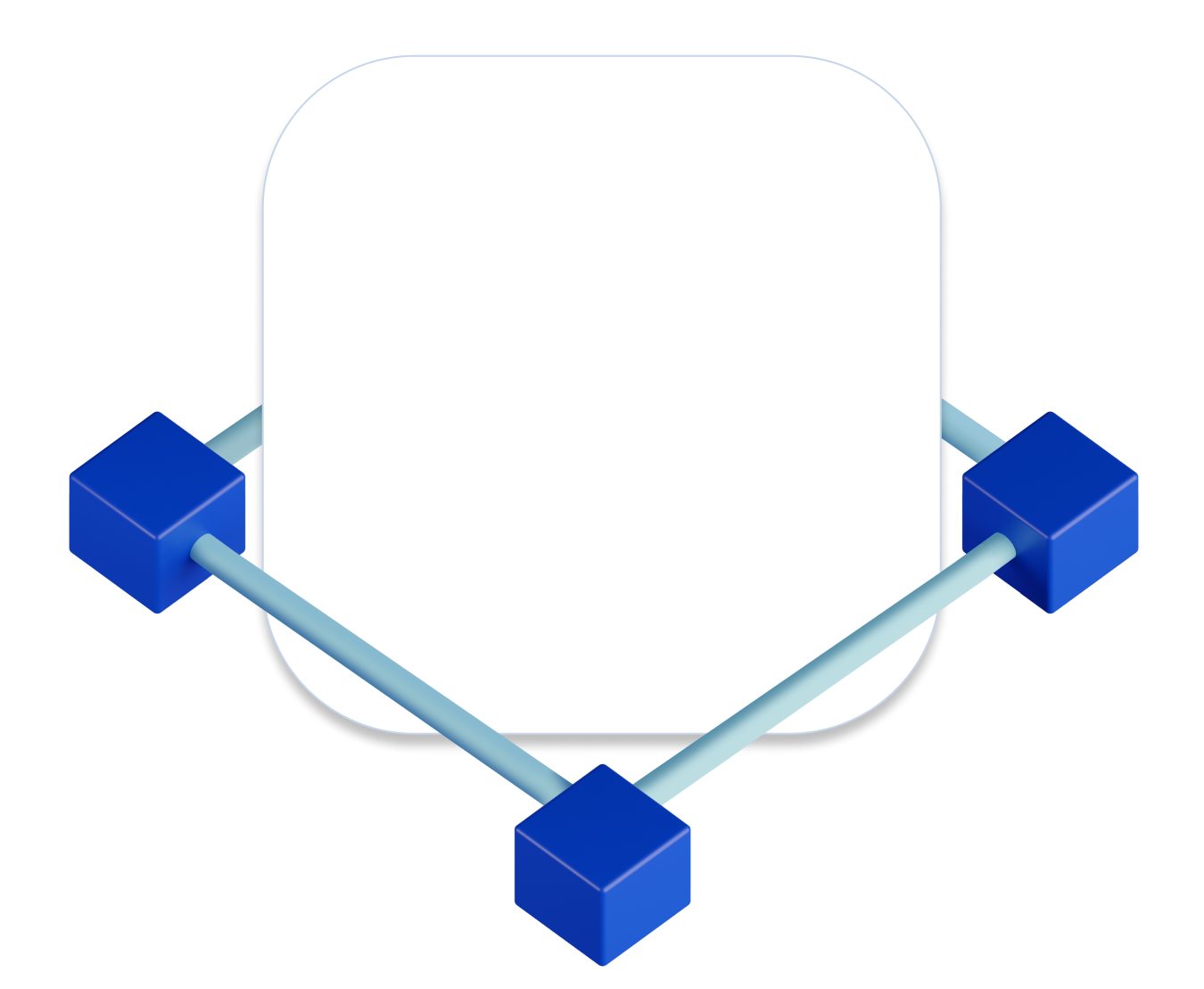

Renzo Protocol Stats
$ 977.2M
Total TVL Across All Supported Networks
Medium Risk
Generally considered as balanced risk-reward investment
Passive
Control-free. Hold & Earn.
0%
Average APY you can expect on Notum
How to Invest in Renzo on Notum
When investing in cryptocurrency, users are faced with difficult choices, as the market offers multiple options for generating passive income. Staking as a type of investment appeared relatively long ago, but with the growing popularity of cryptocurrency, it has evolved and now offers more attractive and profitable ways to receive rewards.
As known, staking involves locking crypto assets for a certain period to maintain the security of the blockchain technology. Staking gives liquidity providers the opportunity to receive passive income for depositing assets to various platforms and dApps. However, this type of investment has a significant drawback - users do not have access to their assets during the lock-up period, which in some way limits their freedom.
Liquid staking has proven to be a solution to this problem, offering users additional tokens beyond the main rewards that can be used in the DeFi space while the main assets generate income. Another innovation was restaking, which allows investors to restake crypto assets after the initial staking. This means that during restaking, the staked token can still be used for staking on other platforms, which not only increases the utility, but also generates additional income for investors.
Today we will pay attention to the popular protocol for liquid restaking - Renzo, and talk about its operating principles. Notum will also point out its advantages, disadvantages, as well as investment strategy that will help investors receive additional income from restaking assets.
Renzo: the Essentials
- TVL: $3,252B
- Average APY: 1.38%
- Risk Level: Medium
- Blockchains: Ethereum, Arbitrum, Blast, Linea, Mode, Base, BSC
- Foundation Date: 2023
In order to understand Renzo, you must first pay attention to what EigenLayer is and how it works. EigenLayer is the largest restaking protocol on the DeFi market, built on Ethereum. It uses actively validated services (avs) shared security that helps to hyperscale Ethereum and utilizes the security of this blockchain for other projects.
Interesting fact! EigenLayer's TVL exceeds $13,9 billion, making it the largest restaking protocol according to value-locked. In addition, EigenLayer occupies 97.37% of the restaking market, which makes it an absolute leader of this investment type.
While restaking assets on EigenLayer, investors are expanding network security for various dApps. The protocol's dynamic approach not only stimulates users to broaden the ecosystem, but also encourages the emergence of new apps on Ethereum. Now EigenLayer has native restaking and liquid restaking investment options. More details about the protocol can be found here.
Renzo, in turn, is a protocol that acts as a Liquid Restaking Token (LRT) and Strategy Manager for EigenLayer. The protocol also interfaces with the EigenLayer ecosystem, securing Actively Validated Services (AVSs). AVS in EigenLayer work as decentralized services that inherit the security of Ethereum through the protocol.
Interesting fact! Renzo is second in the overall liquid restaking TVL rankings, giving in only to Ether.fi with a TVL of $3,786 billion. At the same time, Renzo is the leading liquid staking protocol on BSC, Arbitrum, Base, Blast, Mode and Linea.
As the EigenLayer’s liquid restaking hub, Renzo aims to get rid of all the complexities associated with the platform and offer users a simple interaction between the platform and EigenLayer node operators. Thus, the main purpose of creating Renzo is to promote widespread adoption of EigenLayer.
«Renzo strongly advocates for EigenLayer and its goal of facilitating permissionless innovation on Ethereum, and programmatically acquiring trust for the ecosystem» - Renzo Protocol Docs.
As a liquid derivative platform built on EigenLayer, Renzo generates more income than can be obtained from ETH staking. For each LST or ETH token invested in Renzo, the protocol mints the same amount of ezETH.
Important! Renzo is designed to “be the primary on-ramp / off-ramp for Ethereum restaking”.
The protocol uses a combination of smart contracts and operator nodes to achieve the best restaking strategy in terms of risk and reward. Thus, Renzo offers a position in which investors want to secure one of the proposed AVS or a combination of them. Each AVS is a kind of entry point for receiving rewards and the corresponding risks. Accordingly, the more AVS a user has, the more strategies there are to secure them.
«The number of strategies possible for securing an activity increases with the number of AVSs. At 15 AVS we will have 32,767 strategies possible» - Renzo Protocol Docs.
ezETH Token
An important part of the Renzo ecosystem is the ezETH liquid restaking token, which shows the investor’s restaked position in the protocol. Thus, users depositing their ETH or LST tokens will receive ezETH in return.
In addition, ezETH also serves as a reward bearing token. That is, underlying restaking positions generate profits, which affects the price of ezETH. Rewards are expected to be paid in the form of ETH, USDC and AVSs tokens. Since it receives more rewards in AVS tokens, the value of ezETH compared to LSTs also increases.
Important! To receive ezETH, investors need to stake their ETH or LSTs on Renzo. However, it is important to remember that unstaking will take 7 days or more depending on AVS.
Speaking of fees, Renzo receives 100% of all EigenLayer rewards, which are divided between protocol treasury and node operators.
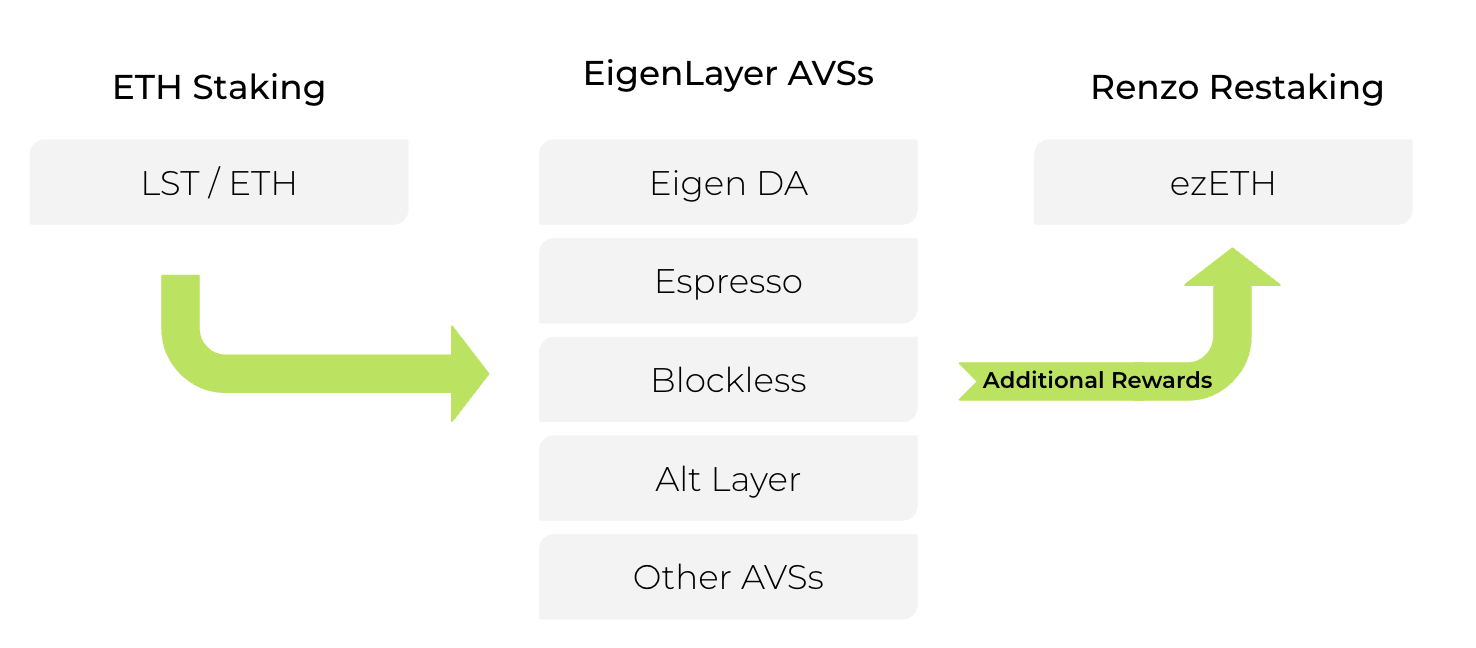
Source: Renzo Protocol Docs
Why Invest in Liquid Restaking with Renzo?
As said, Renzo's main goal is the widespread adoption of EigenLayer, therefore these protocols share a number of similar points. However, Renzo still has its own unique features that set it apart from its competitors.
Pros
L2 native restaking
Renzo cooperated with Connext Network to provide users with cross-chain Native Restaking to layer 2 networks. This means that investors can now restake their ETH/wETH on the leading layer 2 chains collaborating with the protocol.
Transaction costs
By allowing users to restake from EVM-compatible layer 1 chains and layer 2 networks, the protocol significantly reduces transaction costs compared to Ethereum.
Simplified staking experience
Native restaking relieves investors from managing bridge transactions and fees, while offering a simplified and optimized staking process, as well as easy collaboration with node operators.
Safety
The protocol calls security its top priority, so its smart contracts are open source and have been audited by Halborn, which gives users a kind of security guarantee.
Investors
Renzo is supported by a large number of large projects investing in its development. Among them are Binance Labs, Mantle, OKX Ventures, and many others, which indicates decent level of trust from the crypto community.
Renzo ezPoints
Investors who contribute to the protocol’s development receive Renzo points, which vary depending on the duration and nature of participation. Users can get points for holding ezETH and early participation.
Renzo: Investment Strategies
As said, Renzo offers token restaking on six networks to earn rewards and contribute to Ethereum’s safety. To begin with, users need to connect one of the proposed crypto wallets and select a network, after which they can start the restaking process.
Investors can deposit their ETH, wBETH, stETH and wETH to receive ezETH. The APR for providing liquidity on Renzo is 1.38% and is updated every 14 days. As of the end of April 2024, the cost of one ezETH is $3,205.08.
Interesting fact! Renzo has a huge Total Value Restake of $3.30B and over $793 million in EigenLayer Points, which will be fully distributed to ezETH holders.
Renzo App also has a Portfolio tab, where the user can see all their restaked positions. In addition, the protocol offers investors its own Referral Program, which allows them to earn 10% of the points received by their friends. Details can be found here.
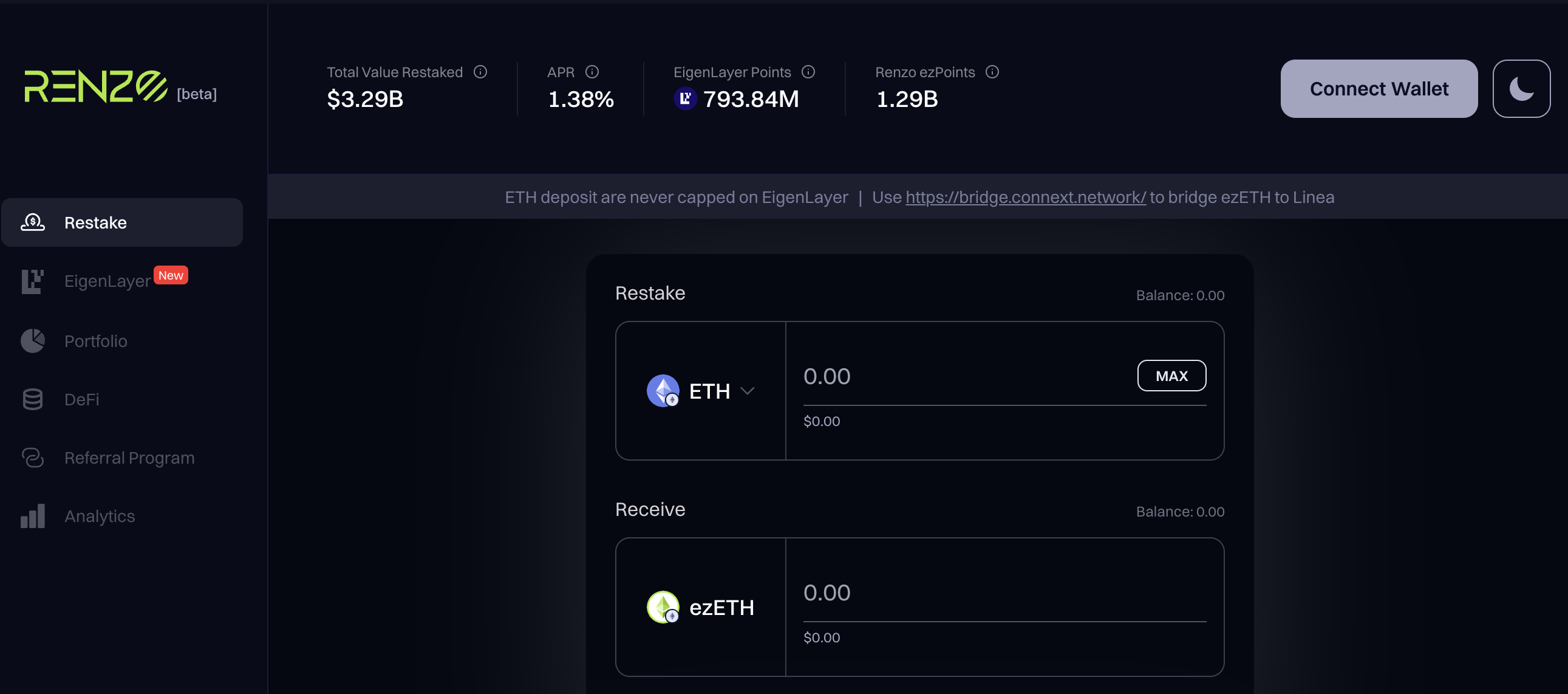
Source: Renzo App
Renzo: Risks and Disadvantages
Along with its advantages and unique features, Renzo protocol is also subject to some risks that are important to consider.
Cons
Smart contract risk
Despite Renzo's audits, no smart contract is 100 percent secure. Thus, if it is discovered that the smart contracts of the protocol contain bugs or vulnerabilities, this may lead to the loss of funds.
Platform's complexity
Even though the Renzo App has simple and intuitive interface, the protocol ecosystem may be incomprehensible to inexperienced users. Since the protocol is directly linked to EigenLayer, it may be difficult for beginners to understand the difference and choose the right investment strategy.
Low APR
At the moment, the APR for providing liquidity on Renzo is 1.38%. Thus, low rewards may encourage users to look for a platform with higher income.
Security risks
During restaking, investors contribute to the security of multiple layers and projects, which exposes them to greater risks.
Notum’s Verdict
Renzo is the EigenLayer’s liquid restaking hub allowing users to deposit their assets to receive passive rewards. This moderate-risk protocol offers greater income than ETH staking and rewards its investors with ezETH tokens.
The protocol offers users numerous advantages, such as leverage points, L2 native restaking, reduced transaction costs, a decent level of security, and much more. Moreover, Renzo strives to cooperate with other DeFi protocols, for example Pendle Finance, to gain wider adoption.
Despite some disadvantages associated with smart contract and security risk, Renzo is one of the best options on the market for investing in liquid restaking in 2024.
Disclaimer: Notum does not provide any investment, tax, legal, or accounting advice. This article is written for informational purposes only. Cryptocurrency is subject to market risk. Please do your own research and trade with caution.
Boost Your Passive Income
Choose from a wide range of investments on Notum. Compare. Make a move.
Get started
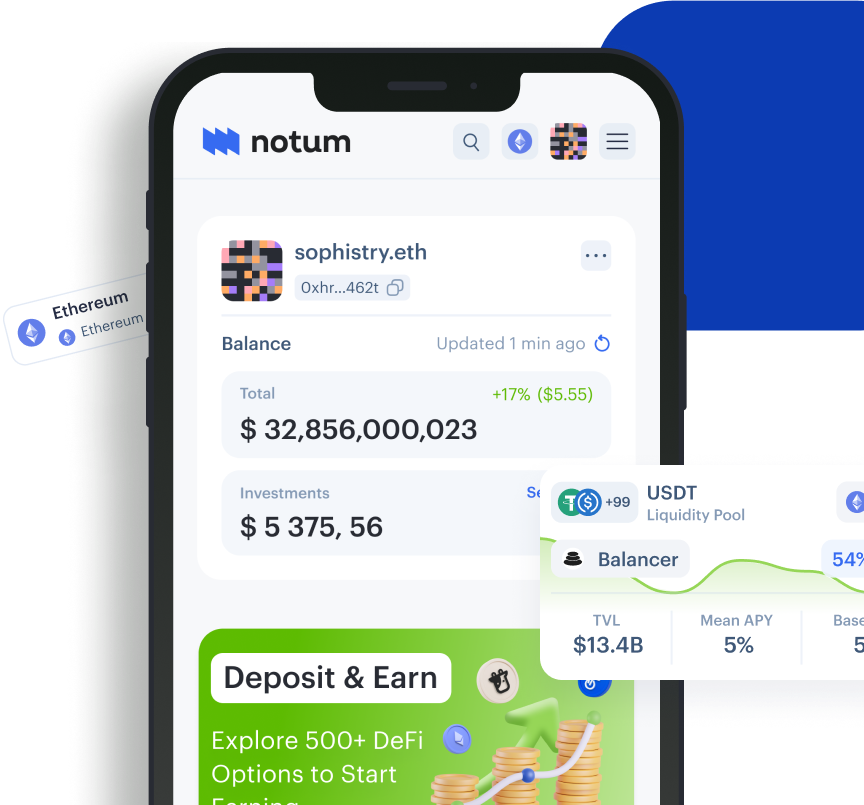
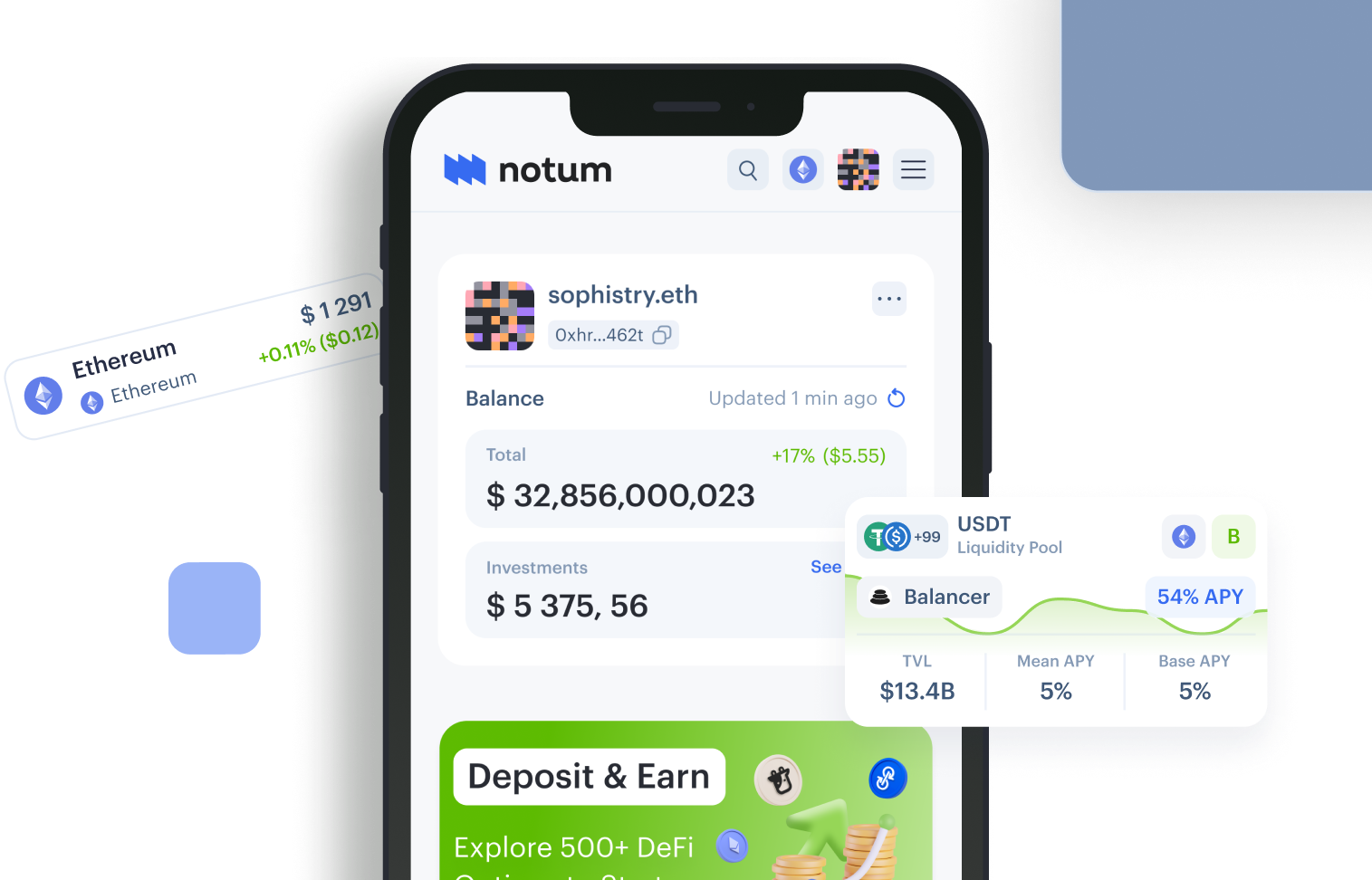
FAQ
1.
What is Renzo Protocol?
Renzo is a liquid restaking protocol that operates as a strategy manager for EigenLayer. In addition, the protocol is EigenLayer’s liquid restaking hub, allowing users to earn rewards for restaking tokens.
2.
How does Renzo Protocol work?
Renzo uses a combination of smart contracts and operator nodes to achieve the best restaking strategy. Renzo's main goal is to promote widespread adoption of EigenLayer.
3.
What is the ezETH token?
ezETH is the liquid restaking token, representing the investor's share in the Renzo protocol. By investing ETH or LST tokens on Renzo, users receive ezETH in return.
4.
How to get Renzo airdrop?
At the moment there is no clear plan on how you can get a Renzo airdrop, however, restaking assets on the platform and getting ezPoints will increase your chances anyways.
5.
Which network does Renzo support?
Renzo protocol supports Ethereum, Arbitrum, Blast, Linea, Mode, Base and BSC blockchains.